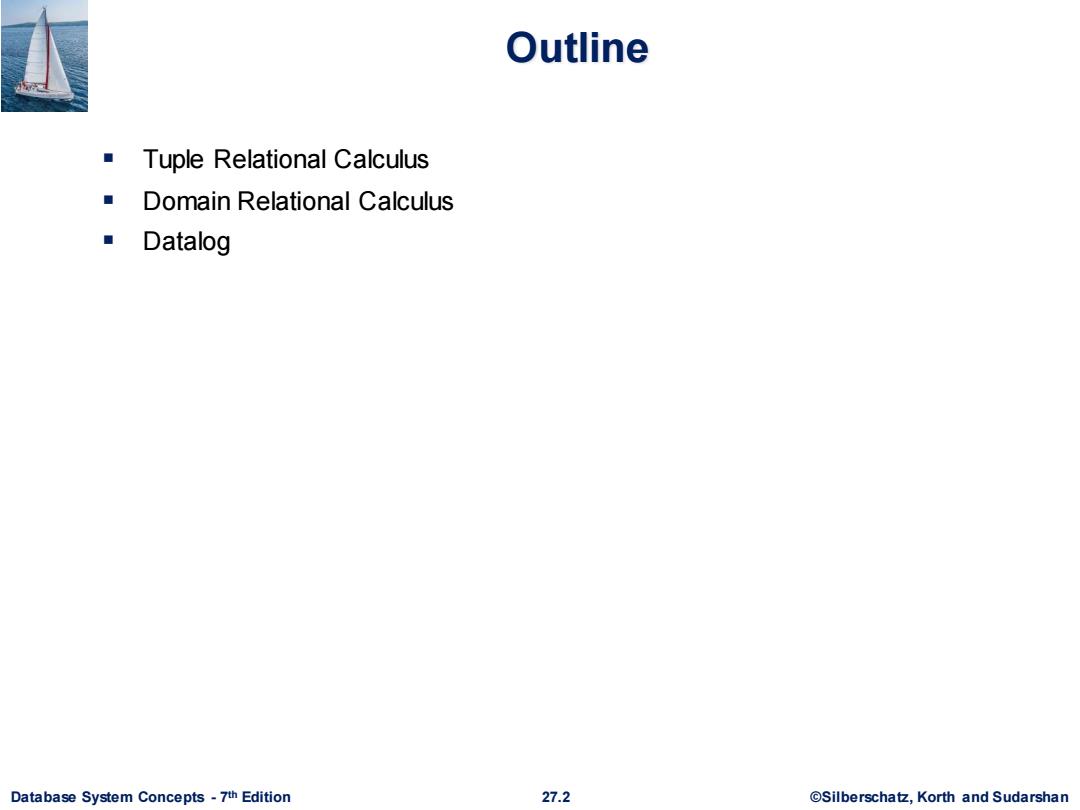
Outline Tuple Relational Calculus Domain Relational Calculus ■ Datalog Database System Concepts-7th Edition 27.2 @Silberschatz,Korth and Sudarshan
Database System Concepts - 7 27.2 ©Silberschatz, Korth and Sudarshan th Edition Outline ▪ Tuple Relational Calculus ▪ Domain Relational Calculus ▪ Datalog
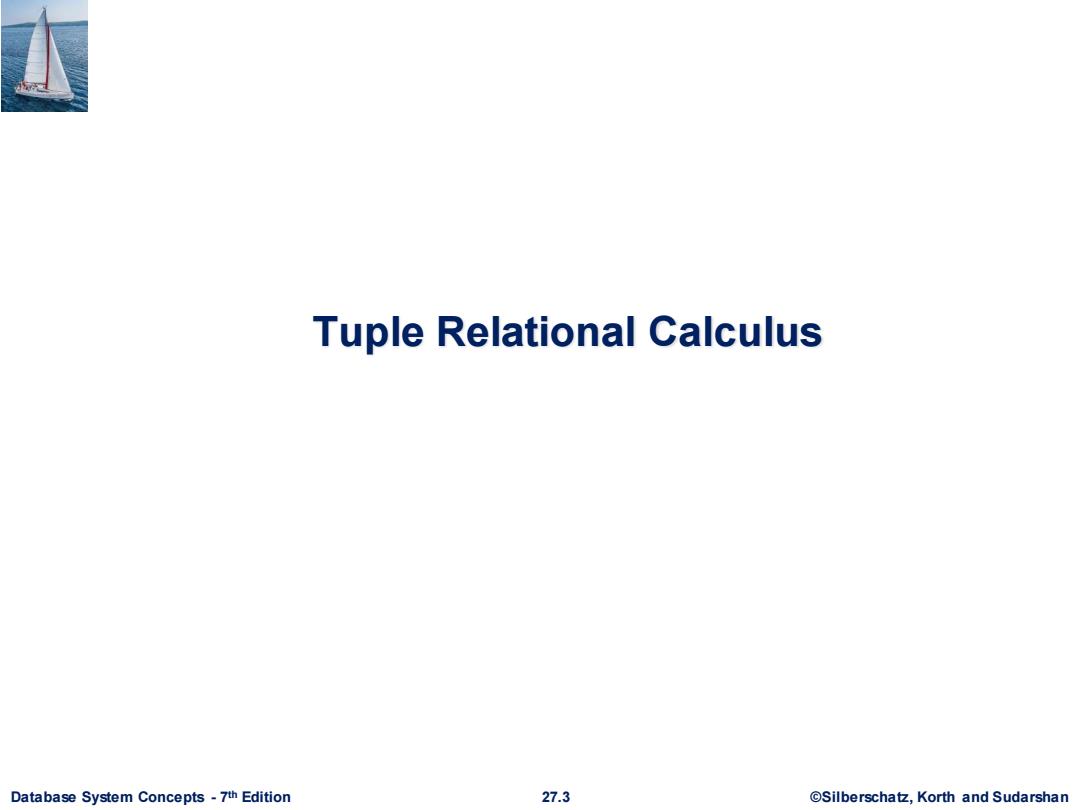
Tuple Relational Calculus Database System Concepts -7th Edition 27.3 @Silberschatz,Korth and Sudarshan
Database System Concepts - 7 27.3 ©Silberschatz, Korth and Sudarshan th Edition Tuple Relational Calculus
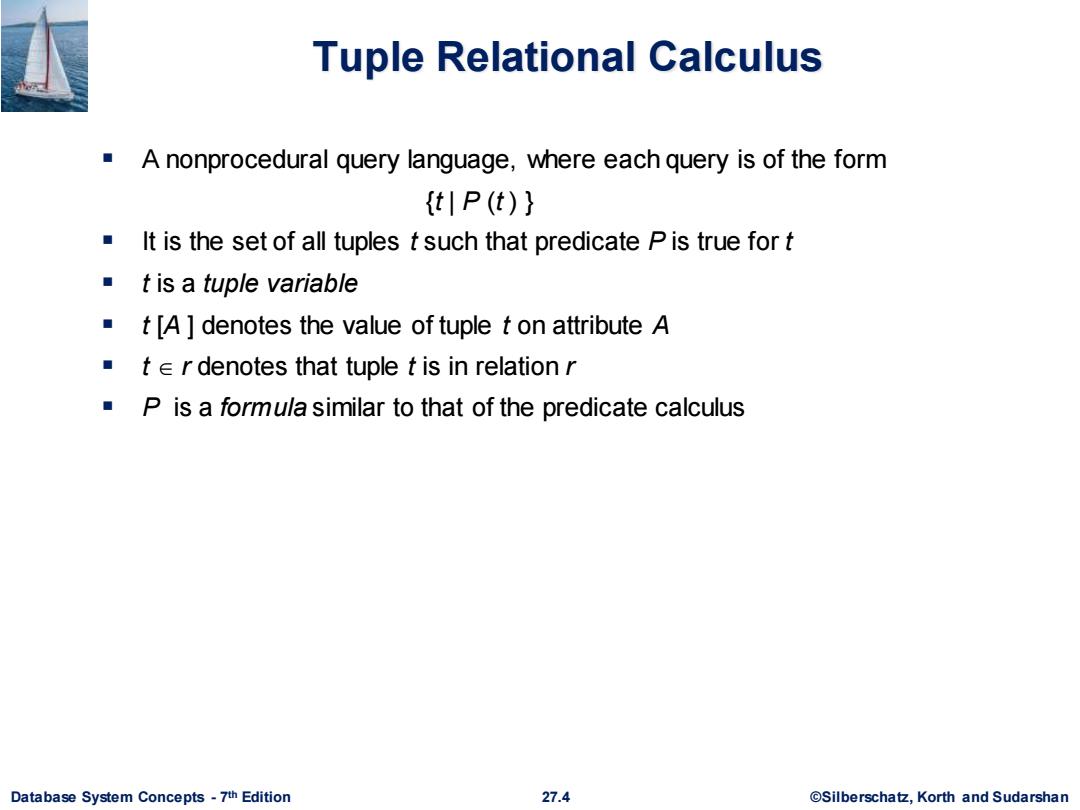
Tuple Relational Calculus A nonprocedural query language,where each query is of the form {t|P(t)} It is the set of all tuples t such that predicate P is true for t ■t is a tuple variable t [A denotes the value of tuple t on attribute A f e r denotes that tuple t is in relation r P is a formula similar to that of the predicate calculus Database System Concepts-7th Edition 27.4 ©Silberscha乜,Korth and Sudarshan
Database System Concepts - 7 27.4 ©Silberschatz, Korth and Sudarshan th Edition Tuple Relational Calculus ▪ A nonprocedural query language, where each query is of the form {t | P (t ) } ▪ It is the set of all tuples t such that predicate P is true for t ▪ t is a tuple variable ▪ t [A ] denotes the value of tuple t on attribute A ▪ t r denotes that tuple t is in relation r ▪ P is a formula similar to that of the predicate calculus
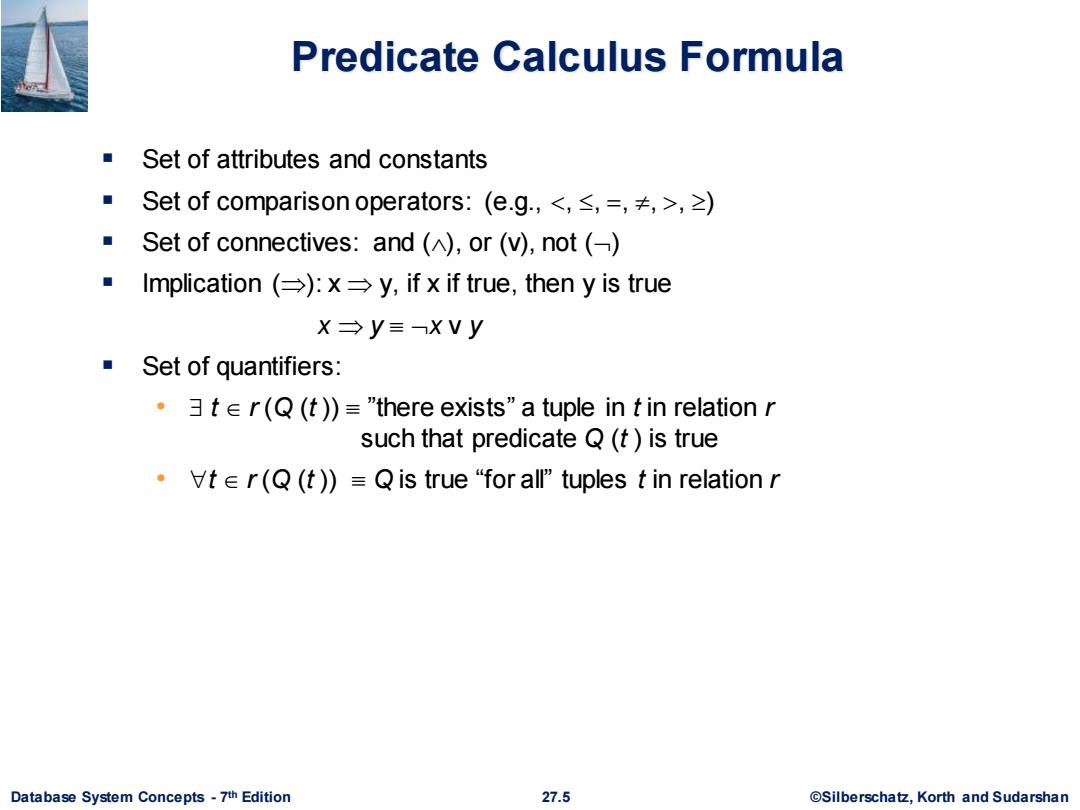
Predicate Calculus Formula Set of attributes and constants Set of comparison operators:(e.g,,≥) ■ Set of connectives:and (A),or (v),not ( ■Implication(→):x→y,if x if true,then y is true X→y=XVy Set of quantifiers: ·3t∈r(Q(t)="there exists”a tuple in t in relation r such that predicate Q(t)is true 。tt∈r(Q(t))=Q is true“for all"tuples t in relation r Database System Concepts-7th Edition 27.5 ©Silberscha乜,Korth and Sudarshan
Database System Concepts - 7 27.5 ©Silberschatz, Korth and Sudarshan th Edition Predicate Calculus Formula ▪ Set of attributes and constants ▪ Set of comparison operators: (e.g., , , =, , , ) ▪ Set of connectives: and (), or (v)‚ not () ▪ Implication (): x y, if x if true, then y is true x y x v y ▪ Set of quantifiers: • t r (Q (t )) ”there exists” a tuple in t in relation r such that predicate Q (t ) is true • t r (Q (t )) Q is true “for all” tuples t in relation r

Example Queries Find the ID,name,dept_name,salary for instructors whose salary is greater than $80,000 {t|t e instructor^t[salary >80000) Notice that a relation on schema (ID,name,dept_name,salary)is implicitly defined by the query As in the previous query,but output only the /D attribute value (t3s einstructor (t [ID ]=s [ID ]^s [salary ]>80000)) Notice that a relation on schema(/D)is implicitly defined by the query Database System Concepts-7th Edition 27.6 ©Silberscha乜,Korth and Sudarshan
Database System Concepts - 7 27.6 ©Silberschatz, Korth and Sudarshan th Edition Example Queries ▪ Find the ID, name, dept_name, salary for instructors whose salary is greater than $80,000 ▪ As in the previous query, but output only the ID attribute value {t | s instructor (t [ID ] = s [ID ] s [salary ] 80000)} {t | t instructor t [salary ] 80000} Notice that a relation on schema (ID) is implicitly defined by the query Notice that a relation on schema (ID, name, dept_name, salary) is implicitly defined by the query
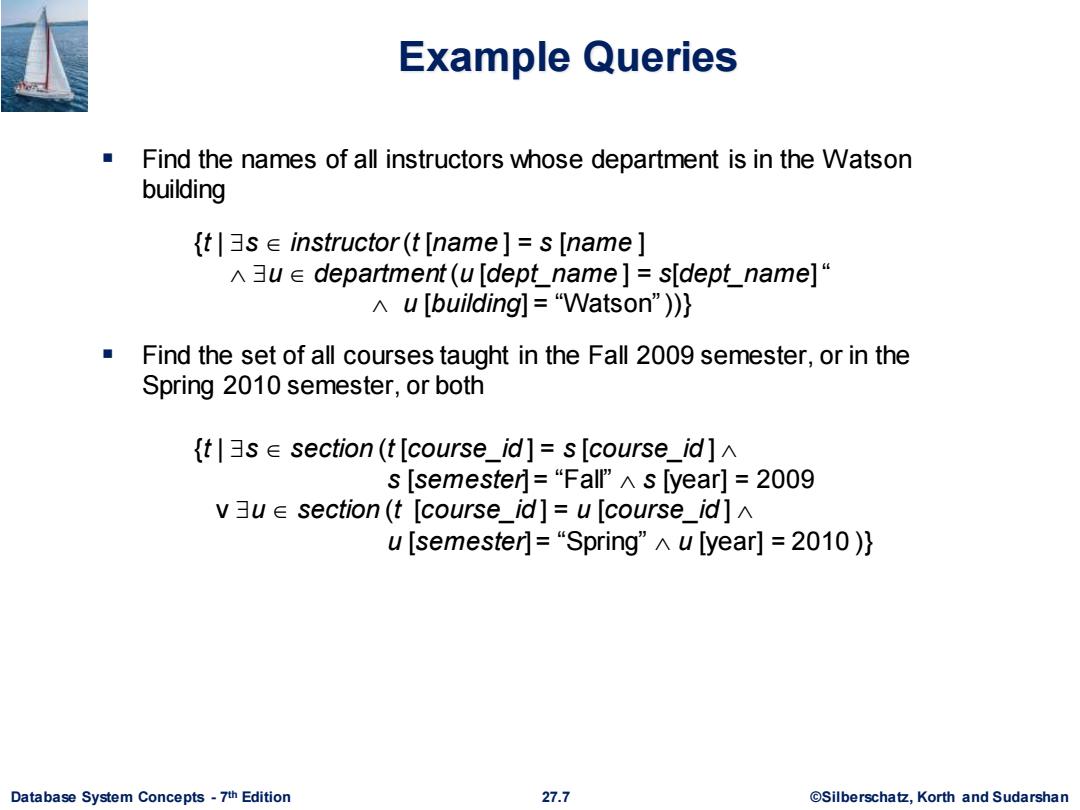
Example Queries Find the names of all instructors whose department is in the Watson building {t|3s e instructor(t [name]=s [name Au∈department(u[dept_name]=s[dept_name]“ Au[building]=“Vatson"”)} Find the set of all courses taught in the Fall 2009 semester,or in the Spring 2010 semester,or both {t3s e section(t [course_id]=s [course_id] s [semester]="Fall^s [year]=2009 v3ue section(t [course_id]=u [course_id] u[semester]=“Spring'”^u [year]=2010)} Database System Concepts-7th Edition 27.7 ©Silberscha乜,Korth and Sudarshan
Database System Concepts - 7 27.7 ©Silberschatz, Korth and Sudarshan th Edition Example Queries ▪ Find the names of all instructors whose department is in the Watson building ▪ Find the set of all courses taught in the Fall 2009 semester, or in the Spring 2010 semester, or both {t | s section (t [course_id ] = s [course_id ] s [semester] = “Fall” s [year] = 2009 v u section (t [course_id ] = u [course_id ] u [semester] = “Spring” u [year] = 2010 )} {t | s instructor (t [name ] = s [name ] u department (u [dept_name ] = s[dept_name] “ u [building] = “Watson” ))}
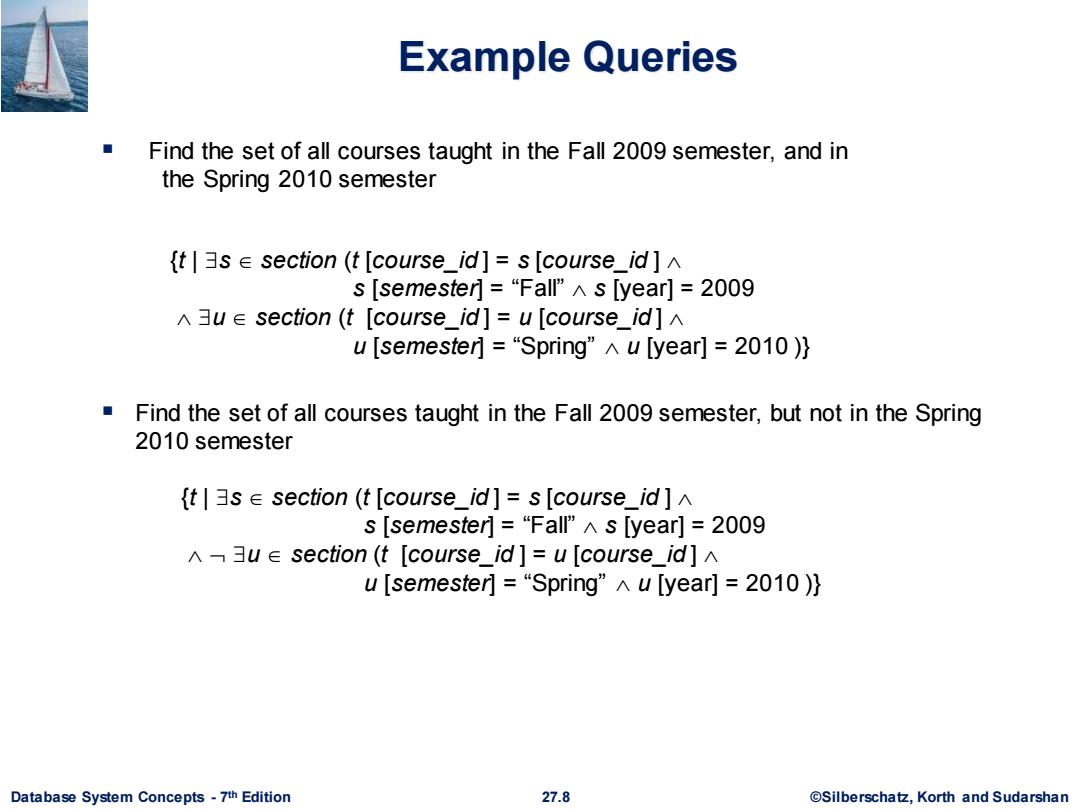
Example Queries Find the set of all courses taught in the Fall 2009 semester,and in the Spring 2010 semester (t |3s e section (t [course_id]=s [course_id s [semester]="Fall"^s [year]2009 A3u∈section(t[course_id]=u[course_id]∧ u[semester]=“Spring”∧u [year]=2010)} ■ Find the set of all courses taught in the Fall 2009 semester,but not in the Spring 2010 semester {t |3s e section (t [course_id]=s [course_id s [semester]="Falls [year]2009 3ue section (t [course_id ]=u [course_id] u[semester]=“Spring”Au[year]=2010)} Database System Concepts-7th Edition 27.8 ©Silberscha乜,Korth and Sudarshan
Database System Concepts - 7 27.8 ©Silberschatz, Korth and Sudarshan th Edition Example Queries {t | s section (t [course_id ] = s [course_id ] s [semester] = “Fall” s [year] = 2009 u section (t [course_id ] = u [course_id ] u [semester] = “Spring” u [year] = 2010 )} ▪ Find the set of all courses taught in the Fall 2009 semester, and in the Spring 2010 semester ▪ Find the set of all courses taught in the Fall 2009 semester, but not in the Spring 2010 semester {t | s section (t [course_id ] = s [course_id ] s [semester] = “Fall” s [year] = 2009 u section (t [course_id ] = u [course_id ] u [semester] = “Spring” u [year] = 2010 )}
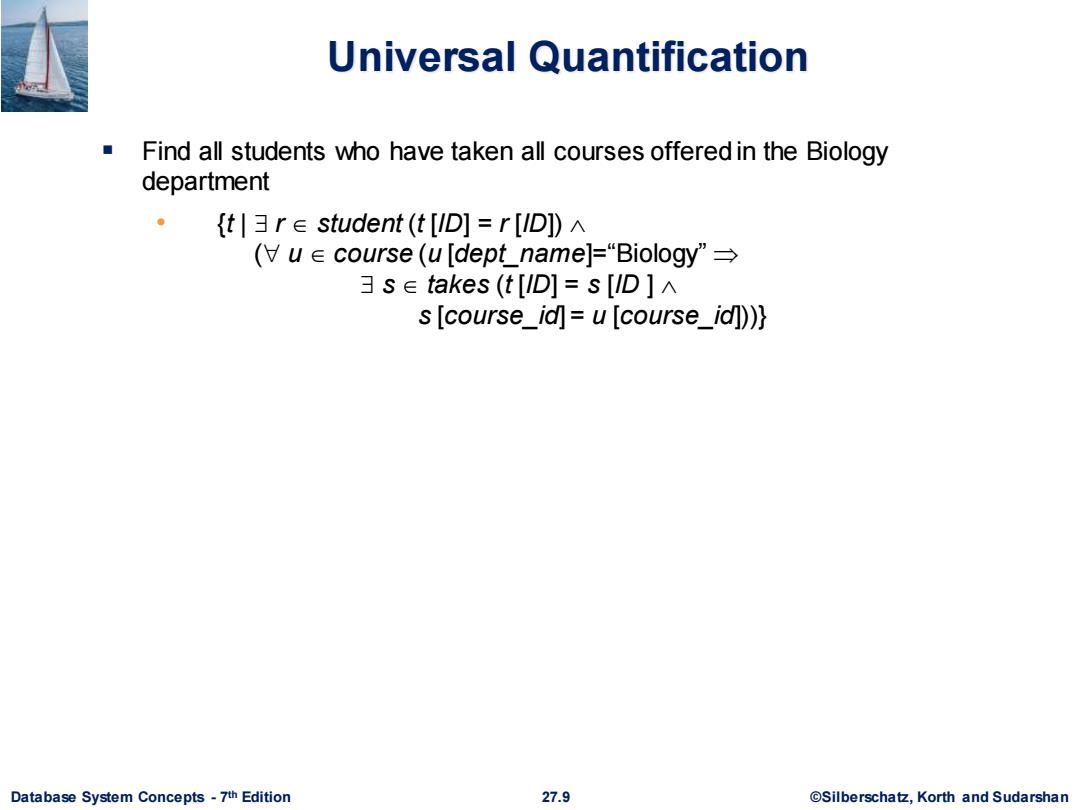
Universal Quantification Find all students who have taken all courses offered in the Biology department {t3re student (t [ID]=r[ID]) (tu∈course(u[dept_name]=“Biology”→ 3s e takes (t [ID]=s [ID s [course_id]=u [course_id )) Database System Concepts-7th Edition 27.9 @Silberschatz,Korth and Sudarshan
Database System Concepts - 7 27.9 ©Silberschatz, Korth and Sudarshan th Edition Universal Quantification ▪ Find all students who have taken all courses offered in the Biology department • {t | r student (t [ID] = r [ID]) ( u course (u [dept_name]=“Biology” s takes (t [ID] = s [ID ] s [course_id] = u [course_id]))}
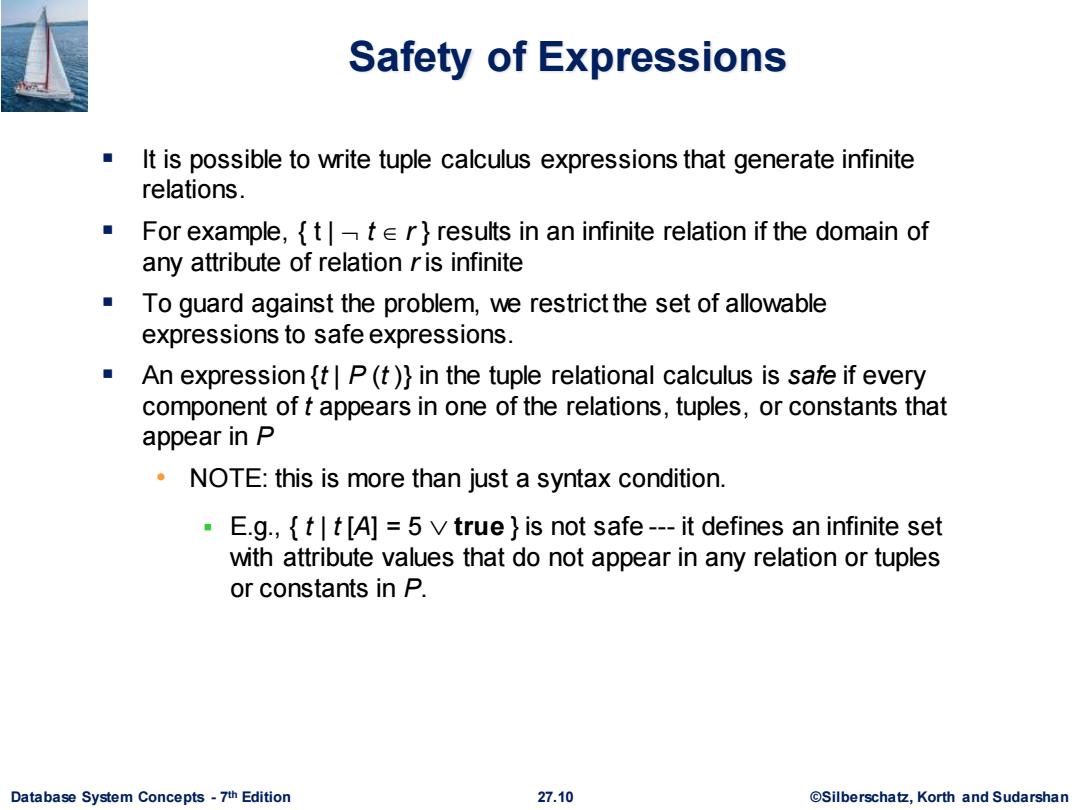
Safety of Expressions It is possible to write tuple calculus expressions that generate infinite relations. For example,{ttr}results in an infinite relation if the domain of any attribute of relation ris infinite To guard against the problem,we restrict the set of allowable expressions to safe expressions. An expression {t P(t)}in the tuple relational calculus is safe if every component of t appears in one of the relations,tuples,or constants that appear in P NOTE:this is more than just a syntax condition. E.g.,{f|f [A]=5 v true is not safe---it defines an infinite set with attribute values that do not appear in any relation or tuples or constants in P. Database System Concepts-7th Edition 27.10 ©Silberscha乜,Korth and Sudarshan
Database System Concepts - 7 27.10 ©Silberschatz, Korth and Sudarshan th Edition Safety of Expressions ▪ It is possible to write tuple calculus expressions that generate infinite relations. ▪ For example, { t | t r } results in an infinite relation if the domain of any attribute of relation r is infinite ▪ To guard against the problem, we restrict the set of allowable expressions to safe expressions. ▪ An expression {t | P (t )} in the tuple relational calculus is safe if every component of t appears in one of the relations, tuples, or constants that appear in P • NOTE: this is more than just a syntax condition. ▪ E.g., { t | t [A] = 5 true } is not safe --- it defines an infinite set with attribute values that do not appear in any relation or tuples or constants in P
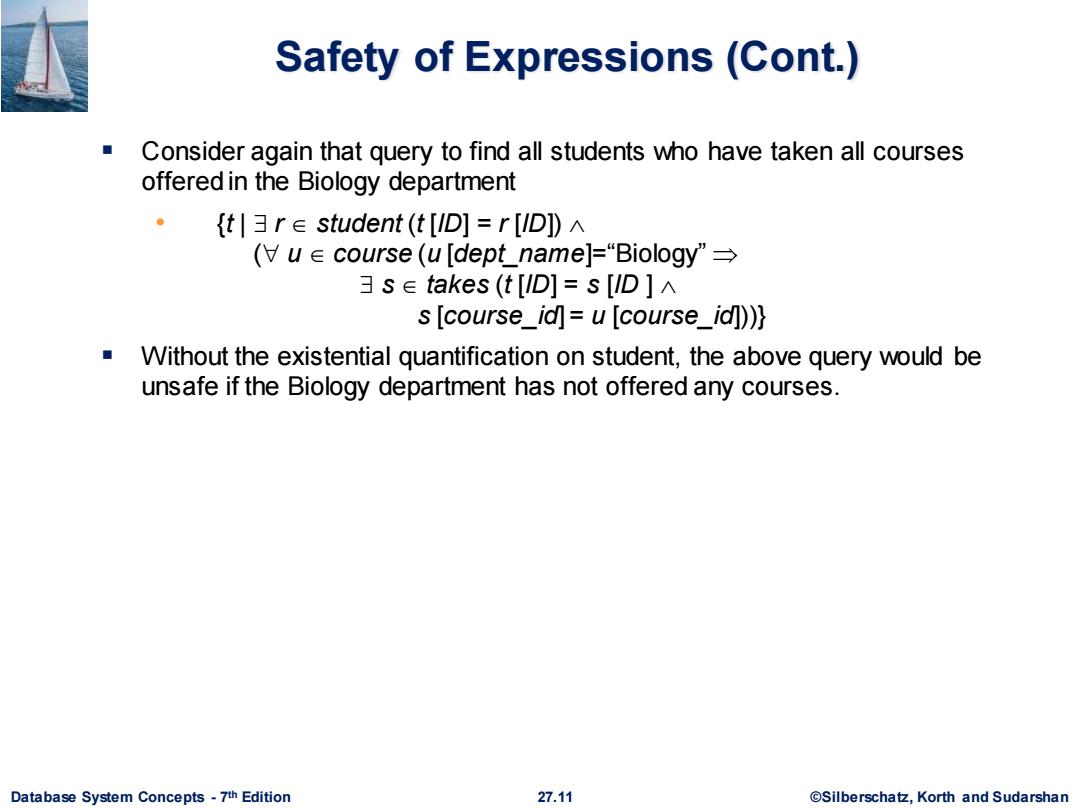
Safety of Expressions (Cont.) Consider again that query to find all students who have taken all courses offered in the Biology department 。 {t3rE student (t [ID]=r[ID]) (tu∈course(u[dept_name]=“Biology'→ 3s e takes (t [ID]=s [ID s [course_id]=u [course_id]))} Without the existential quantification on student,the above query would be unsafe if the Biology department has not offered any courses. Database System Concepts-7th Edition 27.11 ©Silberscha乜,Korth and Sudarshan
Database System Concepts - 7 27.11 ©Silberschatz, Korth and Sudarshan th Edition Safety of Expressions (Cont.) ▪ Consider again that query to find all students who have taken all courses offered in the Biology department • {t | r student (t [ID] = r [ID]) ( u course (u [dept_name]=“Biology” s takes (t [ID] = s [ID ] s [course_id] = u [course_id]))} ▪ Without the existential quantification on student, the above query would be unsafe if the Biology department has not offered any courses